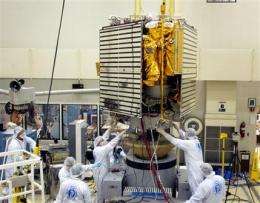Mercury visible Sunday as NASA craft approaches

Earth is about to get better acquainted with its oddball planetary cousin, Mercury, a rocky wonderland of extremes.
Sure, Mars may fascinate science fiction authors, Jupiter looms large and Saturn has stunning rings, but tiny Mercury can claim the title as weirdest planet in the solar system. It has the wildest extremes from hot to cold. A day on Mercury somehow lasts longer than its year. And maybe strangest of all, scientists think it holds tons of ice in dark craters despite being the planet closest to the sun.
On St. Patrick's Day, for the first time, a small NASA spacecraft called Messenger will enter into Mercury's orbit, circling at times as close as 125 miles from the planet's surface. And by coincidence, a few days before that will be the best time all year for people on Earth to see Mercury with the naked eye.
Barely bigger than our moon but much more distant, Mercury is not easy to see without a telescope. An odd pairing with giant Jupiter will make it easier to spot starting Sunday - probably the best opportunity for a year, said Geoff Chester at the U.S. Naval Observatory in Washington.
Chester said people in the Northern Hemisphere should look to the west after sunset. Jupiter will be about 10 degrees above the western horizon. Mercury will be about finger's width to the right of Jupiter.
"Mercury has sometimes been called the forgotten planet," said Sean Solomon, the Carnegie Institution planetary geologist who is Messenger's chief scientist. "It is extreme in many respects. It is the smallest, closest to the sun. It is made of the densest materials."
NASA's Mariner probe flew by Mercury in 1974 and 1975, and Messenger has whizzed by it in 2008 and 2009. But this is the first time a spacecraft will attempt the tricky maneuver of entering Mercury's orbit, circling it for a year. To do that, Messenger, overbudget at $446 million, will have to thwart the enormous pull of the sun.
The overall heat on the sunny side of Mercury will melt parts of some of Messenger's instruments, by design, acting as a heat buffer for the more sensitive parts of the equipment. Then the melted parts will refreeze when the spacecraft hits a cooler zone, said Messenger system engineering chief Eric Finnegan.
Meanwhile, Messenger's orbit will be egg-shaped, distorted by the sun's gravity. But that's the sort of thing that's normal for this oddball planet. Mercury itself has a highly elongated orbit that makes its distance from the sun range from 29 million to 43 million miles. Mercury orbits the sun every 88 Earth days, zipping around at a faster pace than any other planet.
Yet its own rotation is downright pokey. It takes Mercury 59 Earth days to rotate around its axis. What that means is that a solar day on Mercury - from noon to noon at the same spot - lasts 176 Earth days, which is two Mercury years.
One myth about Mercury is that it's the hottest planet in the solar system. Actually, that would be Venus. But Mercury has a tenuous atmosphere with wild swings in temperature. When parts of Mercury face the sun, it can be 800 degrees. On the opposite side, it can be 300 degrees below zero, said mission scientist Ralph McNutt of Johns Hopkins University.
Near Mercury's poles there are deep craters gouged by comets and asteroids that "never see any sunlight and haven't for maybe a billion years," McNutt said. And because of that, scientists think the craters have ice - left over from comet strikes. Radar from afar has suggested ice, and it could even be several feet thick, Solomon said.
"You're staring out in the blackness of space and it's extremely cold," Solomon said.
Messenger probably won't be able to take pictures inside the craters, but it will aim devices that should be able to figure out the chemical composition of what's inside, Solomon said.
Mission scientist Jean-Luc Margot believes there will be plenty of data that will help astronomers understand more about the geologic mysteries of Mercury, such as its surprising magnetism and unusually high density: "This will be our first really close look at this enigmatic planet. It's going to be a blast."
More information: NASA's Messenger web site: http://bit.ly/eqUYR8
NASA on Mercury: http://1.usa.gov/fkrpdr
©2010 The Associated Press. All rights reserved. This material may not be published, broadcast, rewritten or redistributed.

















